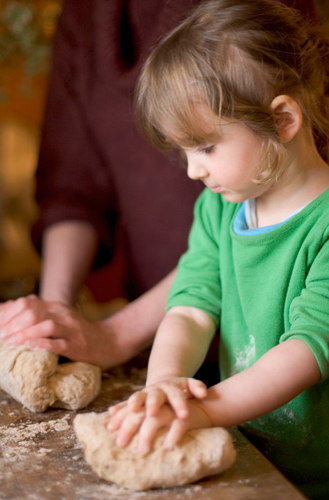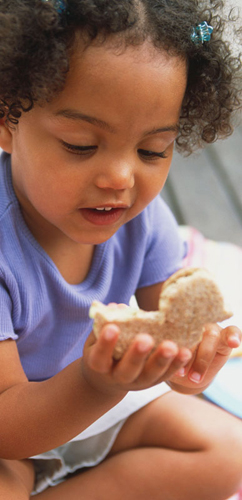What toddlers should eat, how much they should eat,
and how to get them to try new foods are perennial dilemmas for all
parents. The good news is that most fussy toddlers are normal
toddlers—and they grow up to become healthy adults who eat a wide range
of foods.
“Don’t forget to take care
of your toddler’s teeth. By the time he is 36 months old, he will have
all his baby teeth and they will need to be cared for. Help him brush
thoroughly at least twice a day.”
Guidelines for healthy
eating can seem full of contradictions, and concerns about allergies,
food additives, and organics put additional pressure on parents who are
anxious about whether their children are eating well or enough. Combine
this with the average toddler’s tendency to be restless, fussy, and,
occasionally, explosive at mealtimes and the mix can become a potent
cocktail of tension and trouble.
Eating is about more
than health; it is a social skill, too. Sharing food and eating together
have an important role to play in the way we communicate with one
another; family mealtimes are a great opportunity to get everyone
together and share their day. By the time your toddler is 24–30 months,
he will be able to manage three meals a day, plus snacks, and will have
the ability to self-feed using his fingers or a spoon. He can sit
unsupported at the table with everyone else, although he may need a
booster seat to help him reach. This may disrupt grown-up plans for a
peaceful meal, but the involvement will speed your child’s development
much faster than one-on-one spoon-feeding or watching over him. He is
more likely to act “grown-up” if he doesn’t feel different than everyone
else.
Learning about food
Involve your toddler in the kitchen. An early interest in cooking
may give her a more positive relationship with food and make her more
willing to try new things.

Your toddler is a fussy eater
A great many children
develop fussy eating habits at some point, and it may feel as if your
toddler is letting you know that “Any food is acceptable except the food
that is on the menu today!” Try the guidelines for introducing variety. If that doesn’t work, your toddler may have fears linked to food, mess, or texture (see Does your child have a food phobia?).
Your toddler misbehaves at mealtimes
It can be hard for a toddler
to sit still for extended periods of time, and if there is any family
tension at the table you can be certain it will affect his behavior.
Minimize distractions, ignore the unwanted behavior, and follow behavior
guidelines. Encourage him to model his behavior on yours, or an older
sibling if he has one. Check that he is sitting comfortably. If he still
uses a high chair, consider whether now would be a good time to
introduce a normal chair. Likewise, if he is still using a bottle, its
purpose will now be comfort rather than practical necessity.
You are worried that he eats too much or not enough
Most toddlers will eat when
they are hungry, so it is unlikely that he will go without what he
needs. However, he will need your help to regulate his eating and to eat
in a healthy and balanced way. Regular mealtimes and clear behavior
limits will help him to get into the routine of eating. Small healthy
snacks a couple of times a day, rather than “grazing on demand”, will
prevent him from filling up between meals. Make sure that he is always
given plenty of fruit and vegetables and hold back on sugary snacks that
may encourage unhealthy cravings.
You are worried that he is too chubby or too thin
Most toddlers are
plump. However, a toddler who does not exercise, or who is lethargic and
sits around a lot, may be putting on weight and creating health
problems in the future. Consult your pediatrician for advice and healthy
weight guidelines. If your toddler is thin, but you are slim too, there
is probably little to worry about as long as he is eating a balanced diet.
However, any sign of dramatic weight loss, or gain, or change in
appetite should be investigated by your pediatrician. Important note: do
not be tempted to put your toddler on a low-fat diet. He needs his
full-fat foods for healthy bone growth and development.
Your toddler eats too slowly
There is no shortcut to
overcoming this. All you can do is be patient and remember that it is
better to eat slowly than too fast. Keep mealtimes fun. Don’t force him
to eat more than he can manage. Remember that his stomach is very small.
If he has stopped eating, take the rest away; it means he has had
enough.
Your toddler won’t try new foods
Children need time to get
used to new foods before tasting them. Encourage your toddler to help
you to prepare ingredients; describe them and let him play with them.
Don’t worry about mess as undue worry about being clean and tidy may
inhibit him from trying certain textures, such as chunky or wet foods.
Don’t be surprised if he licks unfamiliar foods and then puts them back
on his plate. He is not being naughty; this is his way of experimenting
with the flavor and texture. Be patient and he may well choose to take a
bite next time.
Keep the focus on food and fun
If food looks fun a child will decide that it must taste good, too. Use your imagination when serving your toddler’s food.
Try the following:
Having meals in front of
the TV may seem like a fun idea, but even if that is the choice you
make for yourself, try to make your toddler’s mealtime a more
interactive and personal experience. The idea is to get him used to
self-feeding and consciously enjoying food, without distraction. His
brain is not able to concentrate on more than one thing at a time ,
and so watching TV whilst eating is not a good idea for him at this
age. He will take much longer to learn if there are nonfood-related
events going on at the same time. Mealtime and playtime tend not to go
together for the same reason. At this age, your toddler may need to be
artfully distracted to encourage him to eat or to try new things ,
but toys at the table are not good practice since they will always be
more tempting to your toddler than the meal on his plate, leaving you no
more ahead.
Cut sandwiches into interesting shapes.
Make a mashed potato face using other vegetables.
Use toddler-friendly dishes that reveal a character once the food is eaten.
Make a plate of sliced fruit or vegetables into a face or other picture.
Fun with food
Being creative with a new food, such as making it into an
interesting shape, will get your child’s attention and increase the
chances of her trying it.
